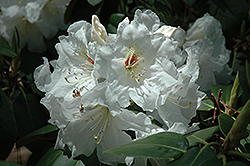Height: 4 feet
Spread: 3 feet
Sunlight:
![]()
![]()
Hardiness Zone: 6b
Description:
A stunning variety with dainty small white blooms accented with faint yellow-green spots; an unusually dense showy accent plant with small twisted leaves; must have well-drained, highly acidic and organic soil, use plenty of peat moss when planting
Ornamental Features
Dora Amateis Rhododendron is covered in stunning clusters of lightly-scented white trumpet-shaped flowers with chartreuse spots at the ends of the branches in mid spring. It has dark green evergreen foliage. The small twisted narrow leaves remain dark green throughout the winter.
Landscape Attributes
Dora Amateis Rhododendron is a dense multi-stemmed evergreen shrub with an upright spreading habit of growth. Its average texture blends into the landscape, but can be balanced by one or two finer or coarser trees or shrubs for an effective composition.
This is a relatively low maintenance shrub, and should only be pruned after flowering to avoid removing any of the current season's flowers. It has no significant negative characteristics.
Dora Amateis Rhododendron is recommended for the following landscape applications;
- Accent
- Mass Planting
- General Garden Use
Planting & Growing
Dora Amateis Rhododendron will grow to be about 4 feet tall at maturity, with a spread of 3 feet. It has a low canopy. It grows at a slow rate, and under ideal conditions can be expected to live for 40 years or more.
This shrub does best in full sun to partial shade. You may want to keep it away from hot, dry locations that receive direct afternoon sun or which get reflected sunlight, such as against the south side of a white wall. It requires an evenly moist well-drained soil for optimal growth, but will die in standing water. It is very fussy about its soil conditions and must have rich, acidic soils to ensure success, and is subject to chlorosis (yellowing) of the foliage in alkaline soils. It is somewhat tolerant of urban pollution, and will benefit from being planted in a relatively sheltered location. Consider applying a thick mulch around the root zone in winter to protect it in exposed locations or colder microclimates. This particular variety is an interspecific hybrid.
Disclaimer - This resource is provided for informational purposes only and does NOT reflect current availability. Inventory varies seasonally, so we cannot guarantee that every plant will be in stock at all times - please contact your favourite GardenWorks location directly for current availability. It does not include our entire inventory of plants, so be sure to visit GardenWorks to see varieties that may not be represented on this list.

